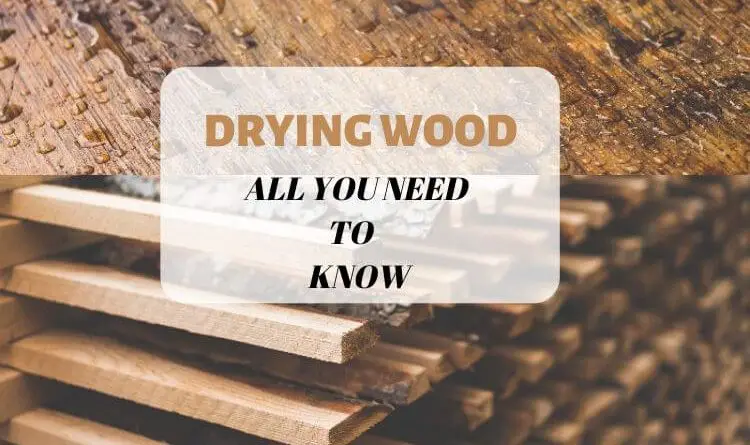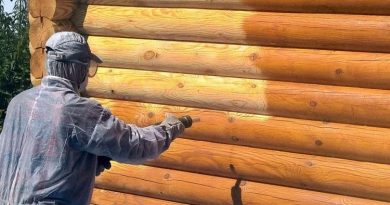Drying Wood: All You Need to Know
Drying wood is a necessary process for the wood used as a building material. That is why it is very important to pay special attention on how to dry wood.
Drying Wood is the process, of reducing a significant part of the humidity of the wood, which makes it stable over time, in size and shape. This advantages makes dry wood perfect choice for woodworking projects or wood burning.
The green wood has a humidity of 35% -45% depending on the essence, and after the drying process its humidity is reduced substantially by about 12% -15%, in order to be used as a building material.
Why is Important to Dry Wood?
When wood is used as a building material, either as a structural element in construction or as a decorative element, it permanently interacts with the environment by absorbing and eliminating moisture, until equilibrium humidity is reached.
As a result of this process of elimination / absorption of water, the wood swells or shrinks, as the case may be, which can cause its deterioration if the drying is done too quickly or uncontrolled.
The drying aims to achieve the moisture balance of the wood, when it is the most stable dimensional and the probability of cracks occurrence is very low.
The wood is considered “green” if its humidity is more than 35%. The dry wood has different humidity depending on the area where it is to be used:
- in constructions 12-20 %
- on the outside 15-17 %
- for burning 20 %
- for furniture 8-12%
- in acoustic musical instruments 6-8 %
Ways To Dry Wood
Wood drying depends on several factors and can be done naturally, in the stack, or forced in special dryers.
Factors influencing the drying of wood are:
- species and type of wood
- board thickness
- the initial humidity
- final moisture
This form of controlled drying takes place in electronically controlled drying rooms, where the humidity simply vaporizes.
The desired final humidity can be determined individually. Usually the humidity of use of wood types is as follows:
- Solid wood for construction max. 15%
- Glued laminated wood for construction max. 12%
The drying process is monitored and can be ordered as needed throughout the entire period.
This is done with special probes inserted into the wood, which are connected to the process computer through an electronic evaluation device.
Attention: The dry wood in the drying room must acclimatize before its installation in heated spaces, spaces that usually have a relative atmospheric humidity of about 30%.
This process may have a different duration, depending on the type of wood.
Drying Wood Naturally
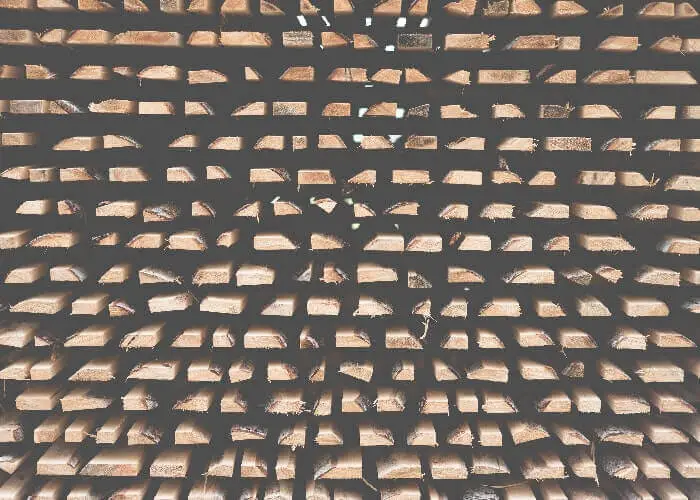
Drying wood naturally represents the removal of water from wood with the help of natural energy sources, for example the sun and wind. It is the oldest drying process of wood.
Natural drying outdoors can be done at a relative humidity of about 50%, but it lasts a long time (4-12 months) and damage due to drying (cracking, form work, wood decay) can be recorded.
For this reason, this type of lumber drying has lost its importance and has been replaced by technical procedures, such as drying in drying rooms.
What to take into account when you dry wood naturally :
Climate and Geographical Area
- Average annual values of air temperature and relative humidity, altitude, direction of prevailing winds, frequency and intensity of the haze, annual average precipitation, exposure to solar radiation, etc.)
Organization of the deposit:
- location on high ground, exposed to the wind, away from obstacles (trees, tall buildings);
- flat and dry land (if it is swampy, it must be drained; the bumps are covered with soil, gravel or slag; the vegetation must be destroyed).
- sufficient distances between stacks;
- the dimensions of the stacks: the height 4 … 8m (but no larger than 3 x the width), the width 1.5 … 4m
- distance from the ground: 50-60cm
- the roof must exceed 0.5m the edges of the stack
- stacking is done with constant thickness grooves
- fir or spruce boards, with 20 x 30mm section;
- located in a strictly vertical plane one above the other;
- inside the stack, the pieces are placed at greater distances than at the edge;
ADVANTAGES
- Energy saving
- Low investment costs
- Simplicity – does not require qualified personnel
DISADVANTAGES
- There is no control over the drying conditions
- Limited value of final Moist (> 12%);
- Exposure to the attack of fungi and insects;
- Increased risk of cracking (especially end cracks);
- Long drying time
Acceleration methods: for reducing the drying time. There are different alternatives (acceleration methods):
- vertical stacking – specific to the rural area;
- stacking in the trunk;
- stacking in the inner basket;
- stack with side fans;
- out in swings.
Drying Wood Forced/Artificially
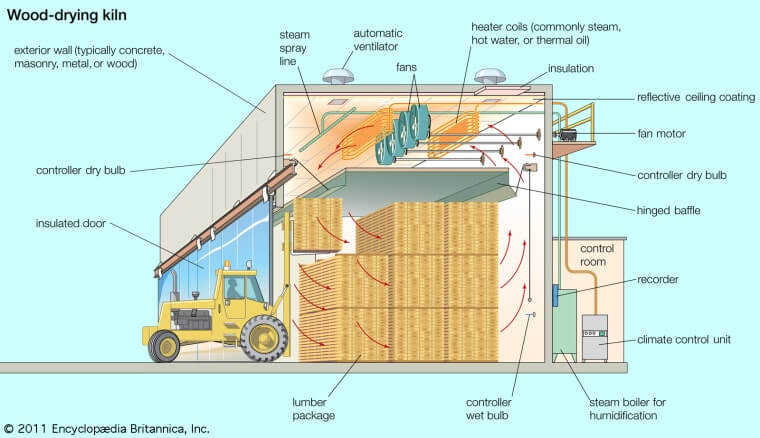
Artificial drying of wood represents the removal of water from wood with the help of special installations, equipped with artificial source of heating and ventilation.
Forced drying wood can be done in several ways depending on the mode of heat transfer.
The most used are:
- by convection
- conventional drying (by air exchange with external medium)
- drying by condensation
- drying at high temperatures
- vacuum drying
- drying in vapors of some organic substances
- drying in hydrophobic liquids (hot oils)
- incubation / compression drying
- freeze drying and sublimation
- mechanical drying (by rotation)
- drying with alternative air movement through the stack
We will take each one of these artificially dry wood methods and explain each one of them.
Conventional Wood Drying
It is the most used and has as a basic principle the removal of saturated air in humidity and its replacement with another with normal humidity.
Using this method it takes 1-7 days for the drying of the softwoods and between 10 and 30 days for the drying of hard species.
If the resin drying is done without problems, in the hard species the method does not have a very good yield, the percentage of cracks being quite high.
ADVANTAGES
- Universal process, through which wood of any species, any thickness, from any initial moisture to any final desire moisture can be dried
- Well-known process that inspires confidence in the purchase.
DISADVANTAGES
- Long duration of drying time
- Poor quality (cracks, dyes) of wood after drying
Drying Wood by Condensation
Drying Wood by Condensation is the most commonly used procedure.
The principle is to eliminate humidity by condensing and reusing the hot air, used in the dryer, instead of draining it out.
The quality of the drying is better, however, for the softwood, the drying time is longer, and in addition the risk of mold and coloration is also higher.
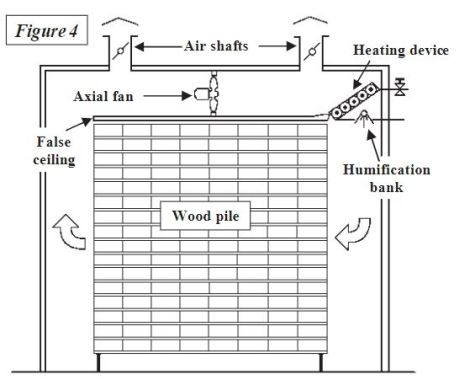
In the dry case by condensation, the air loaded with moisture removed from the wood is absorbed with the help of an axial fan.
At the bottom of the installation and introduced in an attached unit called dehumidifier that works on the principle of the heat pump.
It includes: a cooling battery, a compressor, a heating battery, an axial fan that discharge the dehumidified and reheated air inside the drying plant.
When it passes over the battery, the air cools and the vapors it contains are condensed and removed.
The cooling agent passing through the cooling battery takes in the heat given off by the air during cooling and recovers it by 30% when the air passes over the heating battery.
The drying plant must be additionally equipped with axial fans for circulating air through timber stacks and with electric heating battery to initially raise temp from the installation to 30 degrees.
ADVANTAGES
- Low energy consumption
- Good quality of wood after drying
DISADVANTAGES
- Longer dry time of wood
- Risk of mold and coloration
Drying Wood at High Temperatures
Its principle is the addition of super heated vapors.
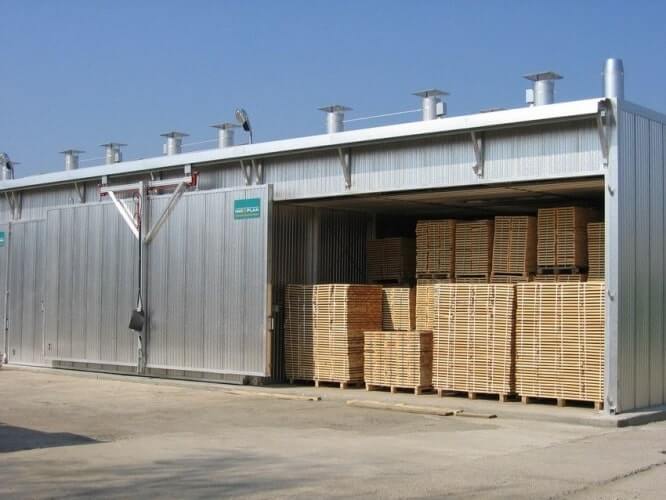
The duration of such drying is halved compared to conventional drying. During drying the temperature reaches up to 230 degrees Celsius, which results in a change in the color of the wood (darker wood is obtained).
However, it has the advantage of much greater dimensional stability and increased resistance to insect attack. Drying Wood at High Temperatures It is preferred method used in construction.
It is obtained by introducing wood in ovens at high temperatures in the presence of steam.
The treatment is 100% ecological, no chemicals of any kind are used and it takes place in three phases:
- The gradual increase of the temperature and the drying of the wood in the oven.
- The temperature rises rapidly to 1000 degrees Celsius, then gradually to 1300 degrees Celsius. In this phase the humidity of the wood is brought to near zero.
- Raising the temperature in ovens up to 185-2200 degrees Celsius and keeping it constant for 2-3 hours. The temperature depends on the use that the treated wood will have, on the outside or inside.
The steam used prevents the burning, cracking of the wood and influences its chemical properties.
Cooling using a sprinkler system and bringing the moisture of the wood to a level of over 4%.
ADVANTAGES
- Drying time reduced by half
DISADVANTAGES
- Risk of cracking
- Melting resin, falling knots
- Color changing (usually it turns darker)
Vacuum Drying of Wood
Vacuum wood dryers are smaller in size and can be a good choice for small and medium-sized factories. The drying time is reduced and the quality is good. It is very suitable for hardwood with evenly distributed pores (eg beech).
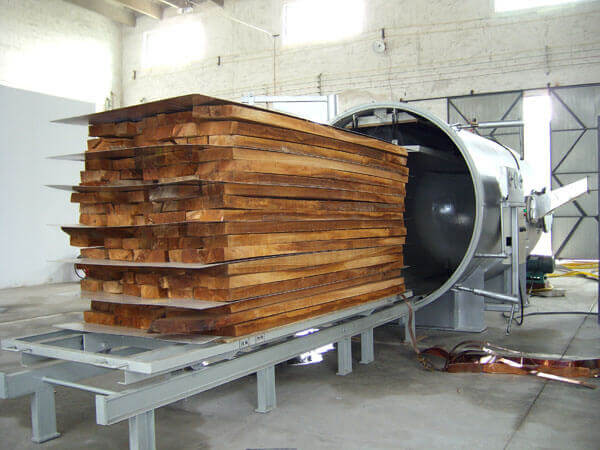
The reduction of the pressure in the drying plant under the value of 1 atmospheres by means of a vacuum pump has positive effects both on the evaporation of the water that is made faster and on the speed of the water moving in the wood.
These are due to:
- reducing the boiling point of the water;
- creating a pressure gradient between the core and the surface of the piece.
Combining these two effects consequently reduces the drying time.
OPTIONS:
- Dry vacuum drying
- Continuous vacuum drying with heating through:
CONTACT (VACUUM / PRESSING DRYING)
ADVANTAGES
- Reduced drying time of wood;
- Good quality
DISADVANTAGES
- Heavy stacking;
- Reduction of the thickness of the pieces;
- End cracks;
CONVECTION ( VACUUM / OVER SHIP DRYING)
ADVANTAGES
- Short duration of wood drying;
- Good quality ;
- Universal process;
DISADVANTAGES
- High cost of the installation;
- Installations of limited capacity (the larger the installation, the more the drying is uneven);
Drying Wood In The High Frequency Electrical Field
It is an expensive method, but it reduces time (up to 70%). It is combined with vacuum drying and is used for drying valuable species.
The quality of the drying is very good, both in softwoods and in hardwoods, due to the low temperatures and the short time. For these reasons neither the colors nor the mold appear.
ADVANTAGES
- Short duration;
- Good quality;
- Universal procedure;
DISADVANTAGES
- the high cost of the installation;
- installations with limited capacity (the larger the installation, the more the drying is uneven)
DURATION:
- 50-70% lower than conventional drying
Difference between natural drying and artificial drying of wood
Natural drying
By natural drying, also known as Air Drying, the wood has a more natural appearance.
Natural drying can take several months, 10 to 16 months, depending on the essence and dimensions of the wood.
Drying cannot be controlled, depending on the atmospheric conditions.
If the natural drying is forcibly accelerated, wood damage can occur.
The equilibrium humidity obtained for the natural dry wood can be uneven on its surface.
If the drying is completed properly, the wood tends to have a more attractive appearance, a better quality and work-ability.
In general, natural dry wood must be acclimated to the new environment before installation.
Dry wood. Drying in dryers / artificial
Drying in professional dryers also called Kiln Dying, leads to a faster and more uniform drying of wood, which allows the installation and application of protective solutions (oil, paint, etc.) immediately.
The wood tends to become more straight with fewer defects of deformation, and the dimensions can be accurately measured.
As a result of the artificial drying, most of the fungi, mold and wood insects are eliminated.
The drying is controlled so that the desired results are obtained. It is possible to obtain precisely a certain humidity of the wood, in a certain period of time.
Drying costs are higher.
Choosing of the Best Drying Procedure Based on Wood Type
Softwoods – drying convection, high temp drying, vacuum drying (if it is very thick assortments), microwave drying (if it is a small amount of wood material)
Beech: drying by condensation (it is cheaper); conventional drying; vacuum drying by pressing (it reduces the duration)
Oak: Natural drying; drying by condensation or conventional; vacuum drying and super heated steam (shorter duration and better horse)
Valuable exotic species: vacuum drying and super heated steam; drying in vacuum (faster and more expensive).
Conclusion
As we have seen each method of drying wood has it’s advantages and disadvantages.
It is up to you which one to choose based on what kind of method you apply. Hope that now you know better the wood drying process.

